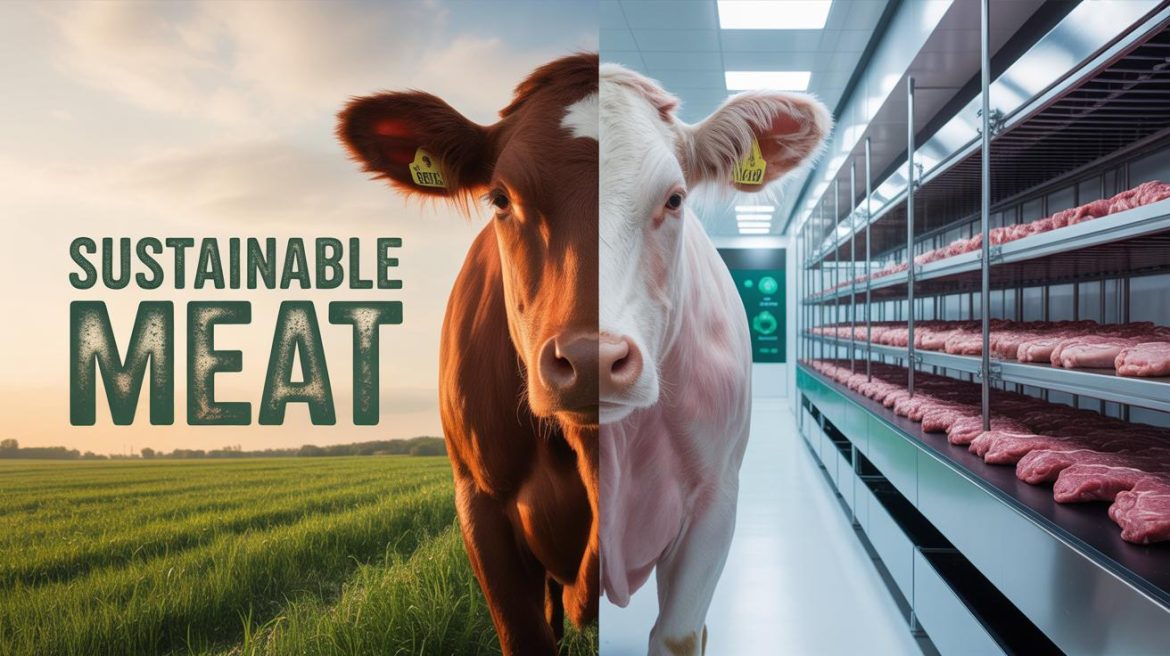Explore the fascinating world of lab-grown meat in “Lab-Grown Meat: Science, Hurdles, and Promise Explained.” This video delves into how cultured meat is crafted in sterile bioreactors, mimicking traditional meat’s taste and texture while promising a sustainable, ethical alternative to conventional livestock farming. Witness breakthroughs like USDA approvals, cost reductions, and cutting-edge 3D bioprinting technology shaping this $25 billion industry. We also discuss environmental impacts, consumer acceptance challenges, and regulatory hurdles shaping the future of meat. Whether it’s lab-grown steak, chicken, or premium foie gras, discover how science and innovation are rewriting our food systems. Don’t miss this balanced documentary-style journey into the future of meat!
Like and share if you find this exploration insightful! #LabGrownMeat #CulturedMeat #SustainableFood #FoodTech #FutureOfMeat
Imagine a world where your next steak dinner comes not from a cow on a farm, but from a lab where cells dance to the tune of science, promising a future free from environmental guilt and animal suffering. This is the bold promise of Is Lab-Grown Meat the Future?, a revolutionary concept also known as cultured meat or cultivated meat, that’s stirring both excitement and debate. As the global population edges toward 9.7 billion by 2050, the pressure on traditional livestock farming—responsible for 14.5% of global greenhouse gas emissions and vast land and water use—has never been greater. Could lab-grown meat be your future meal, a sustainable food hero rewriting the rules of what we eat? Let’s dive into this fascinating journey, exploring its potential, the hurdles it faces, and whether lab-grown steak can be the future of meat.
Is Lab-Grown Meat the Future? is no longer science fiction—it’s happening now. Picture this: a tiny sample of animal cells, like muscle or fat, is placed in a bioreactor, fed nutrients and growth factors, and coaxed into growing into edible tissue that mimics the juicy taste of a lab-grown meat burger or the tender bite of lab-grown chicken meat. The first such burger, unveiled by Dr. Mark Post at Maastricht University in 2013, came with a jaw-dropping price tag of $325,000. Fast forward to 2025, and costs have plummeted to around $17 per pound, thanks to pioneers like Mosa Meat, Aleph Farms, and Vow. This process, often dubbed cultivated meat, aims to replicate the sensory joy of traditional meat without the need for slaughterhouses, making it a beacon of hope for animal lovers and environmentalists alike.
By mid-2025, lab-grown meat news is buzzing with milestones. The U.S. celebrated a breakthrough in 2023 when UPSIDE Foods and GOOD Meat gained USDA approval to sell lab-grown chicken meat, while Australia and New Zealand greenlit Vow’s cultivated quail foie gras in April 2025, set to grace Sydney and Melbourne’s finest dining tables soon. Singapore blazed the trail in 2020 with Eat Just’s cultivated chicken nuggets hitting shelves. The industry’s market value is projected to soar to $25 billion by 2030, though it’s still a tiny slice of the meat market—hybrid products with just 3% cultivated meat account for only 1.4% of U.S. retail sales. Companies like The Better Butchers in Canada are even planning the world’s first cultured meat butchery by year-end, hinting at a culinary revolution in the making.
The allure of lab-grown meat food lies in its promise as a sustainable food solution. Imagine slashing greenhouse gas emissions by 78-96%, energy use by 7-45%, and water use by 82-96% compared to conventional meat, as a 2011 study suggested. It’s a dream for those worried about deforestation and water scarcity, offering a way to feed the world without ravaging the planet. Plus, it sidesteps the ethical nightmare of factory farming, where billions of animals endure cramped, miserable lives. Food safety gets a boost too—produced in sterile labs, it cuts the risk of E. coli or Salmonella, and skips the antibiotics and hormones tied to health worries. Even better, scientists can tweak it to lower saturated fat or boost omega-3s, raising the question: is lab-grown meat good for you? The FDA’s 2022 safety nod is a green light, though long-term health data is still brewing.
But it’s not all smooth sailing. Problems around lab-grown meat cast a shadow over its bright future. The cost remains a sticking point—while down from that $325,000 burger, it’s still pricier than a supermarket steak. Companies are fighting back with plant-based growth media, slashing costs by 80%, and AI-driven cell growth cutting expenses by 40%. Scalability is another beast—current bioreactors are small, but innovations like Believer Meats’ 400% output boost show promise. Then there’s the consumer hurdle. A 2024 Purdue University survey found many cling to conventional meat’s taste and perceived health edge, with some recoiling at the “unnatural” label. Yet, younger generations and European markets are warming up, especially with clear info on its environmental and ethical perks. Regulatory roadblocks add tension—some U.S. states and Europe’s strict 18-month novel food testing period have sparked bans and delays.
UPSIDE Foods has made waves with its approval to sell cultivated chicken in the United States since 2023, leveraging scalable bioreactors to push production forward. GOOD Meat also gained USDA approval in 2023 for its cultivated chicken, pioneering cost reductions with plant-based media. Vow scored a win in April 2025 with cultivated quail foie gras approval in Australia and New Zealand, targeting the luxury market with a unique offering. Aleph Farms is working toward approval in Israel by March 2025 for cultivated beef steaks, using cutting-edge 3D bioprinting technology. Mission Barns completes USDA approval for cultivated pork fat in the United States, focusing on optimizing fat for enhanced taste.
So, can lab-grown steak be the future of meat? The answer hinges on tackling these challenges head-on. The industry is at a thrilling pivot point, with lab-grown meat news showcasing both leaps and stumbles. AI and scalable bioreactors are game-changers, but winning hearts and minds is key. Imagine a marketing campaign that tackles “Would you eat lab-grown meat?” with transparency—highlighting how it spares animals and saves forests. The diversity of products, from lab-grown chicken meat to premium lab-grown steak and even cultivated seafood or foie gras, shows ambition. By 2030, lab-grown meat could carve out a significant niche, though fully replacing traditional meat might remain a distant goal unless costs align and regulations align.
The environmental debate adds intrigue. A 2023 UC Davis study threw a curveball, suggesting lab-grown meat’s carbon footprint could be up to 25 times higher than beef if powered by fossil fuels. Yet, with renewable energy, it could outshine traditional methods, making the energy source a critical wildcard. This tension fuels the rethinking the future of lab-grown meat, pushing innovators to prioritize green tech.
Consumer attitudes are evolving too. Shows like “Would you eat lab-grown meat Happy TV?”—hypothetical or real—could sway opinions by showcasing taste tests and expert debates. The cultural shift is palpable, with millennials and Gen Z leading the charge, drawn by sustainability and ethics. Still, skeptics linger, wary of untested health impacts or the idea of eating lab-crafted food. Education is the bridge—clear, engaging content could turn curiosity into acceptance.
Looking ahead, the future of lab-grown meat is a canvas of possibility. Imagine a world where lab-grown meat burgers sit alongside plant-based patties on every menu, or where lab-grown steak becomes a status symbol for eco-conscious diners. The technology’s trajectory suggests a growing role by 2030, but its ultimate success depends on cost parity, regulatory harmony, and a cultural embrace. Will it be a niche luxury or a global staple? The answer lies in the hands of scientists, policymakers, and you—the consumer.
As we ponder is lab-grown meat your future meal?, the journey is as exciting as the destination. This isn’t just about food—it’s about reimagining how we live on this planet. With every breakthrough, from AI-optimized production to new market entries, lab-grown meat inches closer to reshaping our plates and our world. Whether you’re cheering it on or raising an eyebrow, one thing’s clear: the future of meat is being written in labs today, and it’s a story worth watching.
Sources
- Lab-Grown Meat: Challenges and Innovations for 2025
- Lab-Grown Meat in 2024 and Beyond
- How Lab-Grown Meat is Revolutionizing What We Eat
- Top 25 Emerging Lab-Grown Meat Companies in 2025
- Lab-Grown Meat Approved in Australia
- Consumer Attitudes Toward Lab-Grown Meat
- Environmental Impact of Lab-Grown Meat
- Health Benefits of Lab-Grown Meat
- Economic Viability of Lab-Grown Meat
- Future of Lab-Grown Meat


